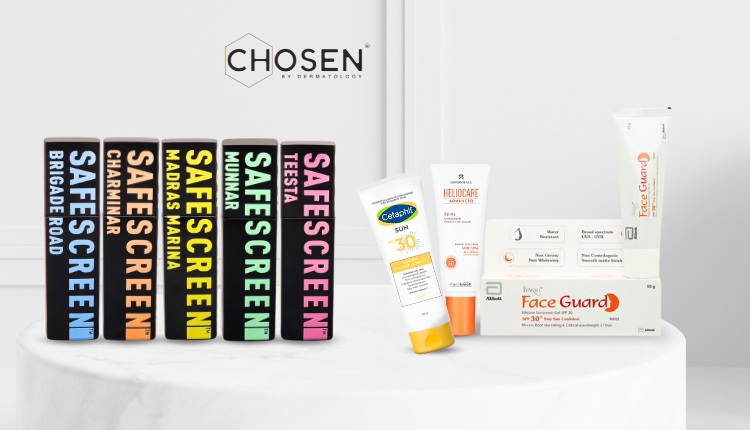Table of Contents
In the world of skincare, sunscreens are an inevitable product. If a skincare routine were a symphony, sunscreens would undoubtedly be the conductor, orchestrating protection against the sun’s potential harm. In this article, we embark on a journey to explore the nuanced aspects of sunscreen selection, ensuring that your choice aligns perfectly with your skin type, workplace environment, climate, and individual skin concerns. Additionally, we will get into the intricacies of choosing the right sunscreens for distinct facial and body needs. Through this comprehensive guide, you’ll gain the knowledge necessary to select the ideal sunscreen for your skin care routine.
The First Step: Knowing the Importance of Sunscreens
Before getting into the realm of customization, let’s revisit the underlying reason for incorporating sunscreens into your skincare ritual. Sunscreens emerge as your skin’s best friend, guarding against the harsh sunlight that has the potential to wreak havoc on your skin’s health. They serve as a protective barrier, shielding you from the sun’s harmful ultraviolet (UV) radiation. Whether you’re at the peak of summer or embracing the colder months, the power of sunscreens remains constant – a reliable companion in your quest for vibrant and healthy skin.
-
Customizing Sunscreens Based on Skin Type
Understanding your skin type serves as the primary step in selecting an ideal sunscreen. Skin types span the spectrum from dry to oily, with variations even within seemingly homogenous environments. Even in humid climates, individuals may contend with dry skin, and conversely, oily skin with acne can persist in colder weather. Thus, the first step toward selecting an appropriate sunscreen involves recognizing your unique skin type.
Chemical vs Mineral sunscreen:
Opt for light lotion or matte mousse sunscreens for oily skin. Dry skin benefits from sunscreen creams or denser lotion formulations. Commence your sunscreen journey with a sunscreen offering an SPF of around 30 like Tvaksh Faceguard for oily skin or Cetaphil Light Gel for dry skin, especially when exploring chemical sunscreens for the first time. Gradually consider higher SPF options to gauge compatibility, as high SPF chemical sunscreens may tend to be oilier, potentially causing occlusion and breakouts initially.
Alternatively, mineral sunscreens, such as SAFESCREEN Madras Marina, are suitable for oily skin, aiding in sebum adsorption. If you lean toward extremely dry skin, consider a moisturizing mineral sunscreen like SAFESCREEN Teesta or Munnar sunscreen.
-
Navigating Sunscreen Selection Based on Climate:
Humidity can pose challenges when it comes to sunscreen adherence and comfort. The moisture-laden air can impact the texture and feel of sunscreens.
Counteracting the Impact:
Balancing Dryness and Moisture: In general mineral sunscreens tend to be drying in nature, while chemical sunscreens tend to be moisturizing in nature. Match this attribute to your location’s humidity level.
Timing Matters: If you find sunscreens feeling heavy, avoid applying them right after showering or washing your face. Waiting at least 15 to 20 minutes allows skin moisture to dissipate. In colder conditions or for dry skin, consider applying a moisturizer immediately after washing and follow up with sunscreen within a few minutes.
-
Safeguarding Your Skin in Varied Environments:
The ambience of places you frequent significantly influence the sunscreen you choose. Sunscreen effectiveness must adapt to your environment for consistent protection throughout the day.
Indoor, Gadget-Laden Settings: For indoor settings dominated by electronic devices, opt for broad-spectrum sunscreens with visible light protection. Sunscreens like SAFESCREEN Munnar and Charminar offer antioxidant-rich options for safeguarding against blue light-induced skin aging and pigmentation.
Outdoor Adventures: If outdoor activities or sweating is in the picture, opt for high SPF protection. Use a 50 SPF sunscreen fluid like SAFESCREEN Brigade Road for a robust defence. To enhance durability, consider a double-layer application. Add a moisturizer underneath in cold and dry outdoor conditions.
Cooking Heat at Home: Shielding against heat from cooking necessitates a sunscreen with Infrared(IR) spectrum protection. Sunscreens like SAFESCREEN Charminar and Munnar provide antioxidant-rich solutions that protect your skin from IR rays aka heat waves.
-
Addressing Individual Skin Concerns with Targeted Sunscreen Selection:
Individual skin concerns demand specific sunscreen selection. Whether addressing pigmentation, acne, or dryness, selecting the right sunscreen plays a pivotal role.
Combatting Pigmentation: To address conditions like melasma, opt for broad-spectrum sunscreens with high SPF. Look for sunscreens explicitly stating protection against UVB, UVA, HEVL, and IR rays. SAFESCREEN Charminar and Munnar mineral sunscreens are potent options with antioxidants for melasma and pigmentary conditions.
Acne: For acne-prone skin, non-comedogenic, sebum-adsorbing sunscreens are the go-to. SAFESCREEN Madras Marina and Brigade Road sunscreens cater to various oily and combination skin types.
Tackling Dryness: People with dry skin can go for a moisturizing mineral sunscreen or add a layer of moisturizer before sunscreen application. Those with dry skin opting for chemical sunscreens should go toward sunscreen creams rather than matte gel formulas.
-
Distinguishing Facial and Body Sunscreen Needs
The skin’s anatomy prompts varying sunscreen requirements for facial and body areas. Factors like oil gland distribution and skin dryness affect these unique needs.
Face vs Body: Different areas necessitate distinct sunscreen formulations. Facial skin has abundant oil glands and thrives with matte to sheer-finish sunscreens. For the body, particularly drier areas like the neck, moisturizing sunscreens are vital. Alternatively, apply a moisturizer before sunscreen on the body.
Leverage Clothing for Protection: Clothing offers substantial sun protection, measured in UPF (UV protection factor). Consider clothing as an effective safeguard, especially for covered body areas.
Sunscreen Sticks and Sprays: While sunscreen sticks are convenient, they might not suit hairy areas. Spray sunscreens are optimal for the body but should be applied in well-ventilated areas to prevent inhaling UV filters.
Conclusion:
By dissecting each facet of sunscreen selection – tailored to skin type, climate, environment, and concerns – you possess the tools for optimal sun protection. With this comprehensive guide, you’re poised to seize the sun’s day while nurturing your skin’s well-being.
See Also:



